Cleaning Special Areas
Cleaning classrooms, conference halls, stores and library using a vacuum cleaner
Classrooms are heavily used; lectures for trainees are held everyday, officers and managers conduct meetings or discussions with their staff, and multiple workshops and training courses are held during various training programmes. Sometimes, classrooms are used even for non-hospital related discussions and training. The much used classrooms and conference halls need to be neat and well arranged so that sessions can run comfortably and smoothly.
Equipment and supplies
- - Cloth
- - Cleaning liquid
- - Soft broom
- - Mop
- - Waste basket
- - Maintenance handbook
Method of cleaning a classroom or conferencehall
- - As with ordinary rooms, dust, sweep and mop the room
- - Tables, chairs and other items in the room should be dusted and cleaned every day. The table and chairs should be arranged neatly in rows unless instructed otherwise
Pay attention to the following details
- - All parts of the room should be dusted
- - Tables and chairs should be wiped thoroughly
- - Window grills and frames should be wiped first
- - The white board, used for writing should be wiped clean, and it should be ensured that the wet duster used for wiping does not leave any stains on it. Wipe the metal strip used for placing the marker pens thoroughly
- - Clean the overhead projector carefully by wiping it with a dry cloth
- - Clean the LCD screen and ensure that there are no marks on it by wiping it with a clean dry cloth
- - Now sweep and mop the room thoroughly
- - The lights and fans should be kept clean. Ensure that they are in good working condition
- - Check if the doors close properly and smoothly Make sure that the hinges do not squeak. If there is a problem, call the carpenter and have it rectified immediately
- - Make sure the door-stoppers are in good condition, otherwise have them replaced
- - Make sure the air conditioner is functioning. If not, inform the electrician
- - Ensure that the doors and windows are closed tight when the AC is in operation
- - An attractive flower arrangement should be kept in an appropriate place
- - Ensure that drinking water and glasses are made available in the classroom / conference hall
- - The waste-baskets should be emptied everyday and placed in the class / conference hall
- - When the class / meeting is over, ensure that the lights, fans and other electrical equipment are switched off
Using a vacuum cleaner
The vacuum cleaner is an expensive electrical machine that must be handled with care. However, if used properly, the vacuum cleaner is an efficient cleaning tool that is well worth the investment. Housekeepers can clean rooms such as the library, the medical records department, rooms with carpets, and store rooms.
These rooms need to be cleaned by vacuum cleaner as it is time consuming to manually clean the rooms. Manually cleaning requires all the books, records, and items stored on the shelves to be removed, cleaned and put back. Though manual cleaning can make a room clean, a vacuum cleaner can remove particles that are not visible to the naked eye, such as dust and cobwebs. They are especially useful in cleaning appliances such as AC units, AC grills, computers, and keyboards. Accessories suited to these different tasks are provided with the vacuum cleaner (Fig. 9.1).

Equipment and materials
- - Vacuum cleaner
- - Paper bag to collect the waste
Assembling the different parts before using the vacuum cleaner
Insert the tube into the equipment and tighten like a screw (Fig. 9.2 & Fig. 9.3).
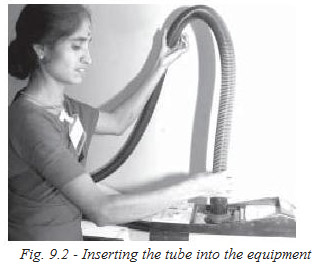
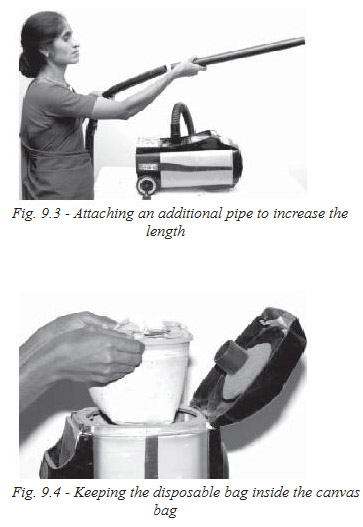

Method of cleaning with a vacuum cleaner
- - A vacuum cleaner can be used in two ways - as a vacuum device and as a blower. When used as a vacuum device, dust and waste is sucked into the waste paper bag. When used as a blower, the pipe blows pressured air into forcefully to reach places to blow dust or waste out. Unlike the blower, the vacuum can remove dust, cobwebs, and litter rather than spreading them around. Therefore, the vacuum is often preferred over the blower. However, there are a few situations when a blower is more useful such as the grooves in a sliding window or door, and shelves stacked with books and files (Fig. 9.6).
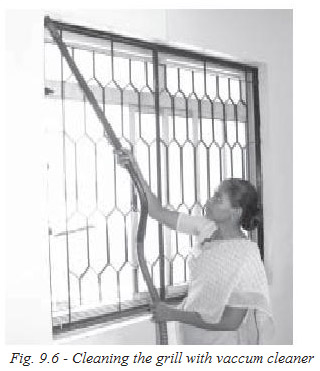
- - The pipe can be elongated or shortened as required
- - The strength of suction or blowing can be adjusted according to need. There are three settings: high, low, and medium
- - The vacuum cleaner should be switched off for five minutes every half an hour to prevent the motor from overheating
- - The vacuum cleaner comes with accessories that can be used for different jobs like dusting,sweeping, cleaning the carpet, cleaning the sofa and mattress, spraying, spray painting, and cleaning the ACs
- - Accessories should be chosen carefully and appropriately. These should be attached properly because loose attachments can break during cleaning
Method of attaching the waste collection bag
When the waste bag is full, it should be discarded and replaced by a fresh bag. Open the vacuum cleaner lid and a waste collection pocket should be visible. The waste collection bag is fitted here. Follow the directions below to exchange the bag. (Fig 9.4 & Fig 9.5).
The method of attaching the bag is given below
- - Stop the device and open the lid by pressing the button
- - Remove the plastic ring
- - Insert a new paper bag inside the canvas bag
- - Grasp the top of the paper bag and fold the upper portion of the paper bag and keep it inside the machine
- - Close the lid
Maintenance of the vacuum cleaner
- - After use, the different parts should be removed, wiped thoroughly and stored safely
- - The machine should always be kept in a vertical position and the pipe should be hung in the shape of the number 8
- - Place a cover over the machine to prevent the accumulation of dust
Key points to remember
- - The appropriate accessory should be used to do an appropriate job
- - Stop the machine for 5 minutes every half an hour
- - Fix the pipe tightly onto the machine. The air pressure can blow the pipe off
- - Discard the waste paper bag when it is full and replace it with a new one
Cleaning the elevator
In a hospital, several people use the elevator (lift) everyday. It is used to carry patients and their attendants to different floors of the hospital building. The lift is also used to carry operated patients, elderly people who have difficulty in walking, wheelchairs, heavy or bulky loads, and garbage disposal carts. The heavily used multi-purpose elevator quickly becomes dusty and dirty; hence it needs to be thoroughly cleaned every day (Fig. 9.7).
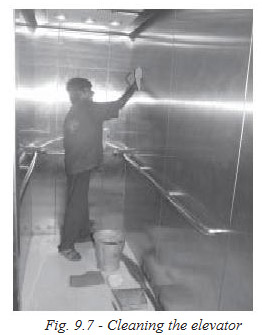
Equipment and supplies
- - Soft broom
- - Dust pan
- - Coir brush
- - Vim
- - A blunt knife
- - Swabbing cloth
- - Cleaning liquid
- - Scrubber
Method of cleaning an elevator
- - Place a notice outside the elevator on each floor stating “The elevator is under cleaning. You are requested to use the stairway. Inconvenience is regretted.”
- - The elevator should be switched off during cleaning
- - Have all the necessary materials and equipment at hand
- - Dust the ceiling and the walls and remove all cobwebs from the corners
- - Sweep the floor and remove the dust.Rinse a swabbing cloth in cleaning liquid and wipe the lift
- - If any pictures adorn the walls of the elevator, remove them, wipe them clean and put back neatly
- - Wipe away any oil or grease on the door
- - Remove the dust and loose soil from the door groove with a brush
- - Any stains on the floor of the lift should be removed using the cleaning solution and a scrubber. If any glue-like substance is stuck to the floor, remove it with the blunt knife carefully to avoid damaging the floor
- - The fan and light should be wiped thoroughly
- - The switchboard should be wiped with spirit
- - Check if the light and fan are working. If not, inform the electrician
- - Inspect the work. Ensure that there are no stains or marks on the walls and floor of the lift
- - When cleaning is completed, switch the elevator back on
- - Remove the notice placed on each floor
- - All the articles used for the cleaning should be returned to the store-room
Key points to remember
- - Place a notice outside the elevator before starting to clean
- - Switch off the elevator before cleaning
Cleaning glass
Glass is present all over the hospital. Windows, doors, photo frames, mirrors, aquarium tanks, cupboards, tabletops and notice boards all have glass material that look beautiful only if they are kept spotlessly clean. Thus glass needs to be cleaned every day.
Equipment and materials
- - Glass-cleaning liquid
- - Lint-free cloth
- - Sponge (Fig. 9.8)

Method of cleaning glass
- - Wipe the glass with a wet sponge to remove the dust
- - Spray the glass-cleaning liquid on the glass
- - Wipe the glass horizontally from left to right, using a lint-free cloth
- - Wipe again, vertically, from the top to the bottom
- - Clean the other side of the glass in the same way.
- - Marks will appear if the glass is not wiped uniformly in one direction, and the glass will appear dirty
- - Inspect the work. Stand at a distance and see if both sides look clear and clean
- - Wipe away any remaining marks on the glass (Fig. 9.9)

Key points to remember
- - The glass-cleaning liquid should be used in the required quantity. If it is used in excess, it will stain the glass
- - Tinted glass should be wiped with a sponge to remove the dirt
- - The dust in corners of the window frames including glass frames on doors should be wiped with a wet cloth and the dust should be removed
- - Both sides of the glass should be wiped in a uniform manner
Cleaning and polishing brass
Equipment and supplies
- - Cloth
- - Brasso- brass polish
- - Cup
- - Toothbrush
- - Cleaning liquid
- - Scrubber
- - Polythene paper
Brass articles are used to decorate the rooms.These articles become dull and tarnished due to chemical changes over time. They need to be polished once a week. Each brass article should be cleaned with the utmost care using brasso, a brass cleaning liquid. When cleaned, the article should shine like new. (Fig. 9.10)
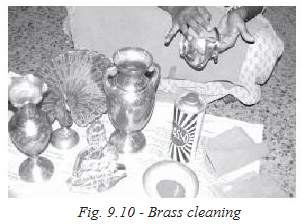
Brass articles in the hospital
- - The kuthuvizhakku (brass lamp) and its stand are used as decorative pieces in the reception area and as puja lamps in the meditation room in some hospitals
- - Large and small brass articles are used as decorative pieces in the reception area of hospitals
- - Flowerpots are placed inside large brass vessels
- - Brass flower vases, plates, “kumkum” container, and small idols also adorn the meditation room
- - Brass flower vases are in rooms such as the dining hall
- - Some nameplates are also made of brass
Method of polishing brass articles
1. The kuthuvizhakku
- - Remove the oil in the kuthuvizhakku
- - Dismantle the lamp and place the different parts of the lamp in a line
- - Scrub all parts of the lamp using the cleaning liquid
- - Use the toothbrush to scrub corners and any engraved figures on the lamp
- - Fold the cloth into 4 or 8 folds, depending on the size of the cloth. Wipe all parts of the lamp to remove the dirt
- - Wipe the lamp dry using a clean cloth
- - Pour the required quantity of Brasso into a cup
- - Dipping a clean cloth into the Brasso liquid, wipe the lamp starting at the bottom and working your way to the top
- - Let the liquid soak into the lamp for 5-10 minutes
- - Wipe the lamp by rubbing it vigorously. Repeat the wiping process three times, each time using a clean cloth
- - Assemble the polished and shining lamp
- - Holding the lamp at the top, very carefully remove any finger marks on the polished surface with a dry cloth
- - Inspect the work. Ensure that there are no marks left on it
- - Holding it with a clean duster or paper so as to avoid finger marks, lift and put it back in its place
2. Immovable and heavy brass articles
Brass items that are heavy and cannot be moved should be polished in its place. Follow the same procedure as above, but polish the article from the top to the bottom. Move the cloth in one direction; otherwise, it will leave marks.
3. Brass plates/Name plates/idols
The brasso and dirt runs into the crevices and grooves of brass articles with designs on them. Follow the same polish procedure as above and take care to remove the dirt and excess brasso with a toothbrush.
4. Brass flower vase
After the brasso is applied to a vase, wipe vertically from top to bottom. When wiping it the second time, wipe horizontally, starting at the bottom. The third wipe is for removing any remaining fingerprints.
5. Brass vessel
A few more steps are required to clean a brass vessel
- - Wash the inside and outside of the vessel with the cleaning liquid
- - Wipe the vessel dry (particularly on the outside) with a clean cloth
- - Apply brasso on the outside and let it soak in for 5-10minutes
- - Polish it uniformly, using the same procedure given above
- - Remove any finger marks in the final polish
- - If a potted plant has to be placed inside the vessel, spread a polythene paper inside. Then place some bricks on the polythene paper, and place the pot carefully on the bricks
- - If water is used in a vessel, scrub the inside everyday with the cleaning liquid and a nylon brush. Wipe the outside with a dry cloth to prevent moss formation
- - Avoid spilling water on the polished surface
Key points to remember
- - Must to have at least 3 dusters for polishing. If a cloth duster is used for one coat of polish do not use it again
- - Brasso is expensive. Do not waste it. Take only the required amount in the cup
- - If a brass article has not been cleaned for a long time, scrub it with a lemon, wash it with the cleaning liquid and polish it with Brasso
- - If marks are still present after polishing and wiping, the article should be wiped again
- - Brasso will not polish alloys such as copper and bronze
For a demonstration on the using of vacuum cleaner, cleaning the elevator, glass and brass items, please watch the video of the CD.
Student exercise
Answer the following
- What are the advantages of using a vacuum cleaner for cleaning?
- What are the points to bear in mind when cleaning the elevator?
- When cleaning glass, why is it important to move the cloth only in one direction?
- Describe the procedure of polishing brass.
- Explain the important points to keep in mind when preparing a conference hall for a meeting.









